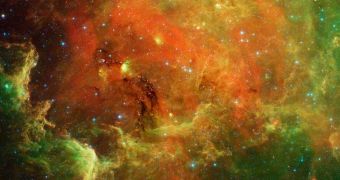When viewed in visible-light wavelengths, the North American Nebula looks somewhat like that famous continent. However, in this new image from the Spitzer Space Telescope, the shape disappears due to the fact that the observations were made in infrared wavelengths.
The shape resembling North America is caused by massive clouds of cosmic dust and hydrogen gas, which obscure researchers' views of what's going on inside the large stellar nursery. Spitzer's keen eyes peered through these veils, right into the heart of the nebula.
According to experts at NASA, this February image is a composite, produced from data collected by the telescope's infrared array camera and its multi-band imaging photometers. The camera snapped multiple wavelengths: 3.6 microns (blue), 4.5 microns (blue-green); 5.8 and 8.0 microns (green) and 24 microns (red.)
The brightest areas in the new image represent hydrogen gas glowing from intense radiations emitted by young, blue stars, no more than several million years old.

 14 DAY TRIAL //
14 DAY TRIAL //